

Arthritis and joint pain showed the largest change in rate reported for musculoskeletal disease conditions between 1996 to 1998 and 2009 to 2011, but much of this increase is probably due to methodological changes in MEPS in 2001 and 2007 that improved the accuracy of capturing these conditions. Spine conditions remained the same, while injuries showed a slight decline in rate, consistent with other reported numbers in this report. Osteoporosis and other musculoskeletal conditions showed slight rate increases. (Reference Table 10.1 PDF [1] CSV [2])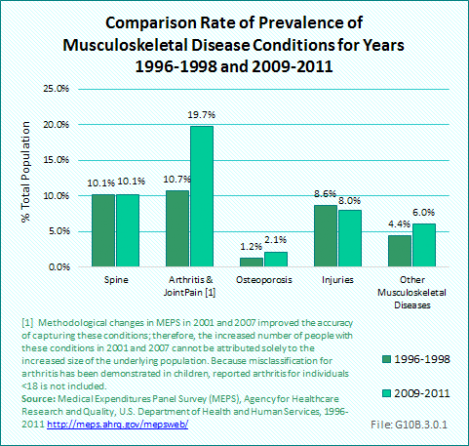
While one in four persons in the "all musculoskeletal diseases" category is older than age 65 years, nearly one-half of osteoporosis cases occur among persons 65 years and older. Only about 15% of persons reporting injuries are in this age range. (Reference Table 10.1.1 PDF [3] CSV [4])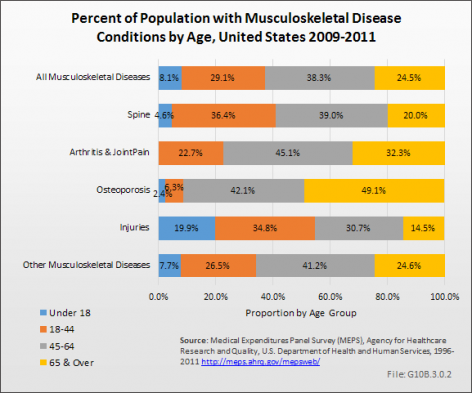
The number of persons reporting a spine condition increased by 3.6 million, from 27.4 million in 1996 to 1998 to 31.0 million in 2009 to 2011, while the prevalence, at 10.1%, was unchanged. The majority of spine conditions occur in working age people, with about 36% among persons age 18 to 44 years and another 39% among those age 45 to 64 years. The higher prevalence among working-age persons is reflected in the prominence of spine conditions in workers’ compensation and disability claims. Nevertheless, one in five spine conditions (20%) occurs among persons 65 years and older, with the rate increasing over the years in this age group. (Reference Table 10.1.1 PDF [3] CSV [4])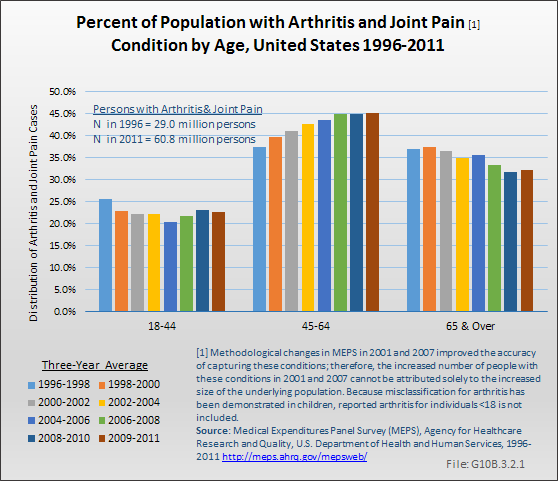
Among the major subgroups of musculoskeletal diseases, arthritis and joint pain have the highest prevalence, reflecting the overall aging population. In 1996 to 1998, 29 million persons (10.7%) reported one or more conditions related to arthritis and joint pain; by 2009 to 2011, 60.8 million persons (19.7%) reported one or more such conditions. However, methodological changes in MEPS in 2001 and 2007 improved the accuracy of capturing these conditions; therefore, the increased number of people with these conditions in 2001 and 2007 cannot be attributed solely to the increased size of the underlying population. The effect of the baby-boom generation aging has resulted in an increase in the proportion of arthritis cases among those age 45 to 64 years as they reach the typical onset age for arthritis. As this wave ages, the proportion of persons with arthritis in the 65-year and older group will increase as well. In 1996 to 1998, 25.6% of persons reporting arthritis were age 18 to 44 years; 37.5% were age 45 to 64 years. By 2009 to 2011, the proportions had changed to 22.7% and 45.1%, respectively. In the next decade, a higher proportion of arthritis and joint pain is expected to occur in persons age 65 years and older. (Reference Table 10.1.1 PDF [3] CSV [4])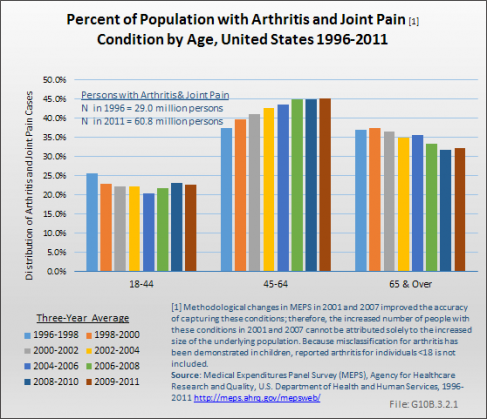
Population aging has also led to a dramatic increase in the number of individuals with osteoporosis. In the period 1996 to 1998, 3.2 million people (1.2% of the population) indicated they had these conditions, but by 2009 to 2011, 6.4 million (2.1% of the population) reported having them. These numbers are substantially lower than numbers reported in other sources, even though the category in this chapter is not limited to osteoporosis-related conditions. In 2002, the National Osteoporosis Foundation projected 44 million persons had osteoporosis. More than two-fifths of persons in the MEPS with these conditions are age 45 to 64 years, increasing the likelihood that these individuals will suffer from falls and fractures for the relatively long future they can expect to live with this condition. (Reference Table 10.1.1 PDF [3] CSV [4])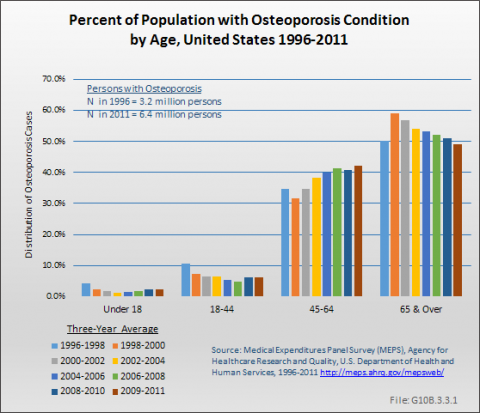
In contrast to spine conditions, arthritis and joint pain, and osteoporosis, the prevalence of musculoskeletal injuries actually decreased slightly although the number of individuals reporting injuries has increased slightly. In 1996 to 1998, 23.4 million persons reported a musculoskeletal injury, while 24.8 million reported such an injury in 2009 to 2011. The prevalence of musculoskeletal injuries remained relatively constant at 8.6% and 8.0% of the population, respectively. Age distribution of injuries may explain why the prevalence hasn’t increased. More than half of injuries occur among persons younger than 45 years, a population segment growing more slowly than those who are older. It is possible improvements in the safety of automobiles and other public health prevention activities have also played a role. Although the MEPS reporting of musculoskeletal injury trends supports trend data previously reported, the overall prevalence is substantially lower than the 65.8 million injury treatment episodes reported in the Injuries section of this report. Injury treatment episodes include total cases treated in doctors' offices, outpatient clinics, emergency rooms, and inpatient admissions in 2010. (Reference Table 10.1 PDF [3] CSV [4])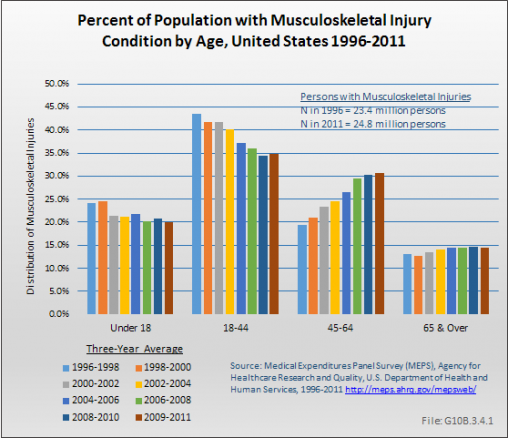
The percentage of the population reporting other musculoskeletal diseases, which include a broad range of conditions of less frequent prevalence, increased from 4.4% to 6.0% between 1996 to 1998 and 2009 to 2011. The total number of persons reporting one or more such conditions increased from about 12 million to 18.6 million. Persons in the age range of 45 to 64 years are the most likely to report other musculoskeletal disease conditions. (Reference Table 10.1.1 PDF [3] CSV [4])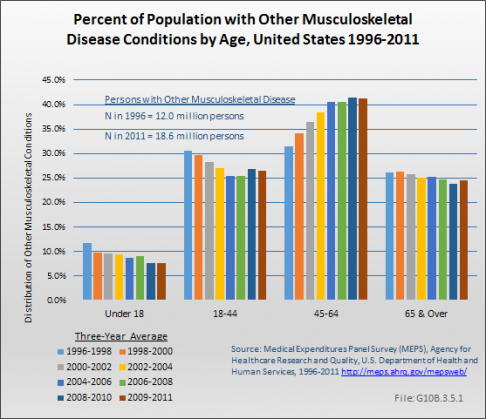
Using the more expansive definition [5] of musculoskeletal diseases, in the period of 2009 to 2011, 87.7 million persons (versus 31.0 million using the more conservative definition) reported one or more spine conditions and 64.0 million (versus 60.8 million) reported arthritis and joint pain. The base and expansive definitions for osteoporosis are identical, so the number of cases for both definitions are also identical, but substantially lower than reported in the Osteoporosis section of this report, as previously noted. The number reporting musculoskeletal injuries was slightly higher than in the more conservative definition (28.3 versus 24.8 million). The increased prevalence in the “other” musculoskeletal diseases category was also substantial, with 71.0 million in the expansive definition versus 18.6 million, as discussed above.
Links:
[1] https://bmus.latticegroup.com/docs/T10001.1.pdf
[2] https://bmus.latticegroup.com/docs/T10001.1.csv
[3] https://bmus.latticegroup.com/docs/T10002.1.1.pdf
[4] https://bmus.latticegroup.com/docs/T10002.1.1.csv
[5] https://bmus.latticegroup.com/2014-report/xl0/economic-cost-icd-9-cm-codes